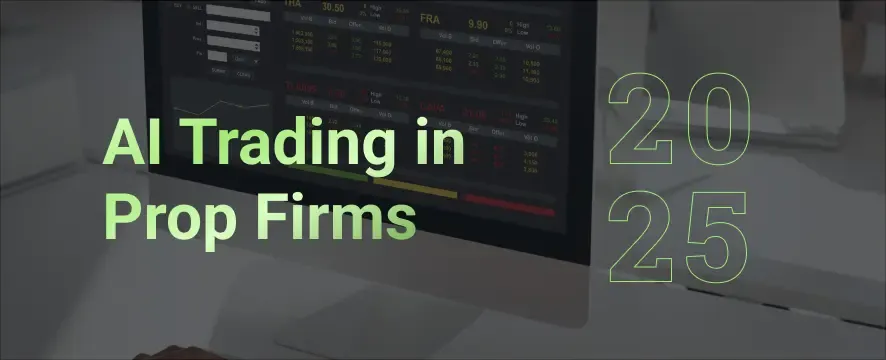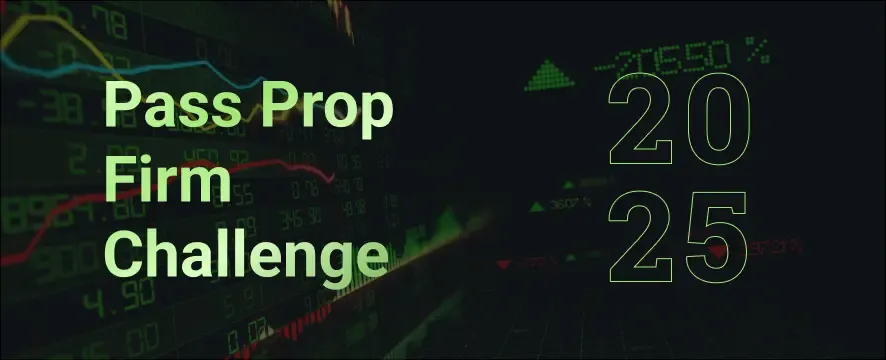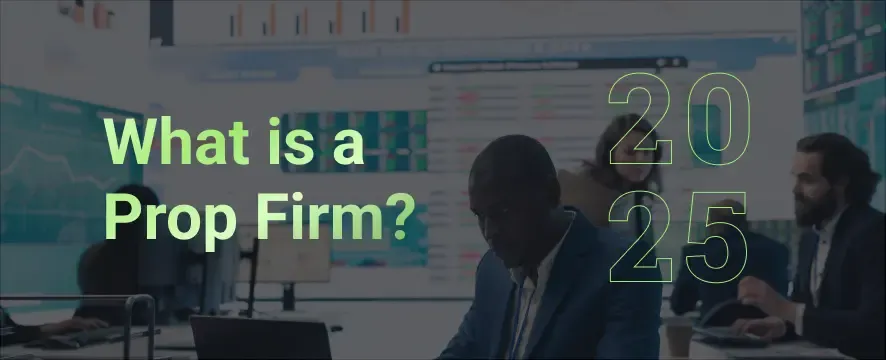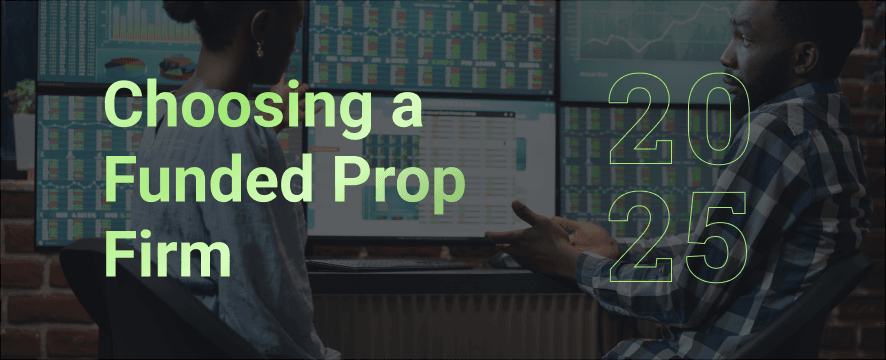
9 min read
AI Trading in Prop Firms: How Automation Is Revolutionizing Funded Trading in 2025
Discover effective AI trading strategies for prop firms to enhance your profits. Learn practical tips to navigate the market successfully. Read more!
9 min read
Share
In this article, we discuss algorithmic trading and how it is shaping the future of Forex trading.
The forex market – the largest and most liquid of all the financial markets in the world – is undergoing a revolutionary shift in how it is traded. Leading this transformative change is algorithmic trading – a tech-driven approach that is reshaping how forex trading fundamentally operates.
it's crucial to understand how algorithmic trading is influencing both the present and future of forex markets.
In this article, we'll explore the world of algorithmic trading forex, examine its current impact on the forex market, and highlight some of the benefits and challenges it brings to both experienced and beginner traders alike. We'll also look at how automated trading is changing the landscape of forex trading and what the future might hold.
Algorithmic forex trading, also sometimes referred to as automated trading or algo trading, utilizes sophisticated computer programs to execute trades based on a set of predefined parameters and criteria.
These computer algorithms analyze vast amounts of market data and execute orders at speeds - and with precision far beyond human capability. This is revolutionizing the way traders are approaching forex trading.
Some of the key components of algo trading in the forex market include:
1. Data analysis: Real-time processing of market data and information
2. Strategy implementation: Execution of complex forex algorithmic trading strategies
3. Order execution: Rapid placement and management of trades
4. Risk management: Automated control of trading risks.
Algorithmic traders in the foreign exchange market are using these systems to gain a competitive edge, often using them to develop and deploy high frequency trading techniques to take advantage of even the smallest price movements of a currency pair.
One of the most common strategies in an automated trading system is the volume weighted average price (VWAP) approach, which helps traders execute large orders with minimal market impact. However, algo trading is also proving particularly beneficial in other strategies, such as auto hedging to protect against risk.
So, the question is: Why has forex algorithmic trading grown at such a rapid pace in recent times? There are three key factors driving this trend in the financial markets - particularly in forex trading.
Constant improvements in processing power and better network speeds have made it possible to process large chunks of data and execute trades with minimal latency, potentially leading to more profitable trading opportunities.
These advancements have opened up new possibilities for high frequency trading and more sophisticated forex algorithmic trading strategies. As technology continues to evolve, we can expect even more advanced algorithmic trading strategies to emerge, along with increasingly sophisticated trading platforms.
Algorithmic trading brings a new level of efficiency to the forex markets by quickly exploiting price discrepancies across various currency pairs and exchanges. This leads to tighter spreads and more accurate pricing, making the forex market more competitive.
The increase in market efficiency has forced traditional forex traders to adapt their trading strategy and embrace technology to keep up with the rapid pace of algorithmic trading.
In the fast-paced world of forex trading, speed and accuracy are critical. High frequency trading algorithms can analyze market conditions and execute trades in a fraction of a second, far outpacing human traders, especially in times of heightened market volatility.
This demand for speed has led to a technological arms race in the forex market, with traders and institutions constantly seeking to improve their algorithmic trading capabilities and trading strategy development.
The continued adoption of forex algorithmic trading has brought several key benefits to traders and the market as a whole:
Algorithmic forex systems can analyze data from several markets simultaneously, executing trades far more efficiently than human traders. This speed advantage allows algorithmic traders to capitalize on short-lived market inefficiencies and execute complex forex algorithmic trading strategies with precision.
One of the biggest challenges for traders is managing emotions and automating trading decisions. Algorithmic trading removes emotions by sticking to predefined rules, leading to more consistent results.
This aspect of automated forex trading can be particularly beneficial for novice traders who may be prone to making impulsive decisions based on fear or greed in manual trading situations.
Algo trading empowers traders to test their forex trading strategies using historical data before risking real capital, improving their odds in live scenarios. This ability to backtest strategies allows traders to refine their approaches and identify potential weaknesses before deploying them in the live forex market.
Algorithms monitor the forex market 24 hours a day, seven days a week, allowing traders to take advantage of opportunities around the clock. This constant monitoring is especially valuable in the forex market, which operates 24/5 and can be influenced by global events at any time.
Algorithmic trading systems can manage multiple strategies across different currency pairs, providing better diversification and risk management.
This diversification can help traders spread their risk and potentially increase their overall profitability in the forex market.
By implementing various forex trading strategies simultaneously, traders can adapt to different markets more effectively than with a single trading strategy.
While the benefits of forex algorithmic trading are clear, it presents several challenges as well:
The push for the best forex trading algorithms has led to a high frequency trading race, where retail traders struggle to compete with larger institutional investors that have access to cutting-edge technology.
This technological gap can create an uneven playing field in the forex market, potentially disadvantaging smaller traders who rely more on manual trading techniques.
Although removing human emotions has benefits, lack of oversight can lead to issues if algorithms encounter unprogrammed scenarios. This risk highlights the importance of combining automated trading systems with human expertise to ensure optimal performance in the forex market.
In certain markets, algorithmic trading can potentially exacerbate volatility, leading to rapid price swings in the forex market. This increased volatility can create both opportunities and risks for traders, requiring careful risk management strategies and regular trading strategy adjustments.
Algorithmic trading has significantly impacted traditional forex trading in several key ways:
Human traders now compete not only with other humans but also with sophisticated computer programs, making the market more competitive.
This increased competition has forced traditional forex traders to adapt their strategies, improve their trading process and embrace technology to remain competitive, often blending manual trading with an algorithmic trading strategy.
The sheer speed and number of algorithmic trades continue to alter market dynamics, with trends forming and dissipating more quickly. This rapid pace of change requires forex traders to be more agile and responsive to market conditions, frequently reassessing their trading strategy.
As algo trading becomes more common, traders will need to continually adapt and adjust their own forex trading strategies to account for the increased presence of forex algorithmic trading systems in the forex market.
This increasing adoption of automated trading may mean traders having to incorporate elements of automated trading into their own trading strategies or developing strategies that can coexist with algorithmic trading, which often requires familiarity with more advanced trading platforms.
Looking ahead, forex algorithmic trading will continue to evolve, especially with AI and machine learning advancements. These technologies are set to push the boundaries of what's possible in automated forex trading.
AI and high frequency trading strategies will likely continue to accelerate the evolution of algorithmic trading, ultimately leading to more adaptive and sophisticated strategies.
Machine learning algorithms can analyze vast amounts of historical data and real-time data to identify patterns and trends that human traders might miss, potentially leading to more sophisticated forex algorithmic trading strategies.
As technology becomes more accessible, retail traders may better compete with institutions, leveling the playing field in the forex market. This democratization of algorithmic trading software could lead to increased participation in the forex market and potentially greater market liquidity.
We may see traders adopting hybrid approaches that combine the strengths of algorithmic trading and human judgment in their trading process.
These hybrid systems could leverage the speed and efficiency of automated trading while incorporating the intuition and flexibility of human traders, potentially offering the best of both worlds in forex trading.
This could lead to the development of a new type of algo trading strategy that blends computational power with human insight.
As algorithmic trading continues to grow in prominence, regulators will likely pay increased attention to its impact on the forex market. This could lead to new regulations designed to ensure fair market practices and protect traders from potential abuses of automated trading systems.
There is no doubt that forex algorithmic trading is shaping the future of the forex market. It offers significant advantages in speed, efficiency, and accuracy while presenting challenges that need careful management.
As the forex market continues to evolve, traders will need to stay informed about the latest developments in algorithmic trading and be prepared to adapt their trading strategy accordingly.
The future of forex trading will likely involve a sophisticated blend of human expertise and advanced technology to make calculated trading decisions and implement the best forex algorithmic trading strategy.
Those who can effectively merge the two, leveraging the strengths of both algorithmic trading and human insight, will be best positioned for success in the ever-changing world of forex trading.
As we move forward, it's clear that algorithmic trading will remain a dominant force in the forex market. Whether you're an experienced trader or just starting out, understanding the role of algorithmic trading in forex is crucial for navigating this dynamic and exciting financial market.

9 min read
Discover effective AI trading strategies for prop firms to enhance your profits. Learn practical tips to navigate the market successfully. Read more!

8 min read
Instant funding prop firms are becoming increasingly popular, but should you participate?

10 min read
Learn effective strategies to successfully pass a prop firm challenge. Gain insights and tips to enhance your trading skills. Read the article now!

16 min read
Discover the essentials of proprietary trading and learn what a prop firm is. Understand the benefits and risks involved. Read the full guide now!

17 min read
Discover essential tips for selecting the right funded trader prop firm to match your trading goals. Read the article to find your perfect trading partner.
Get an insight from other users about SeacrestFunded and their experiences. 131K+ members and counting

Get instant access to weekly newsletter.